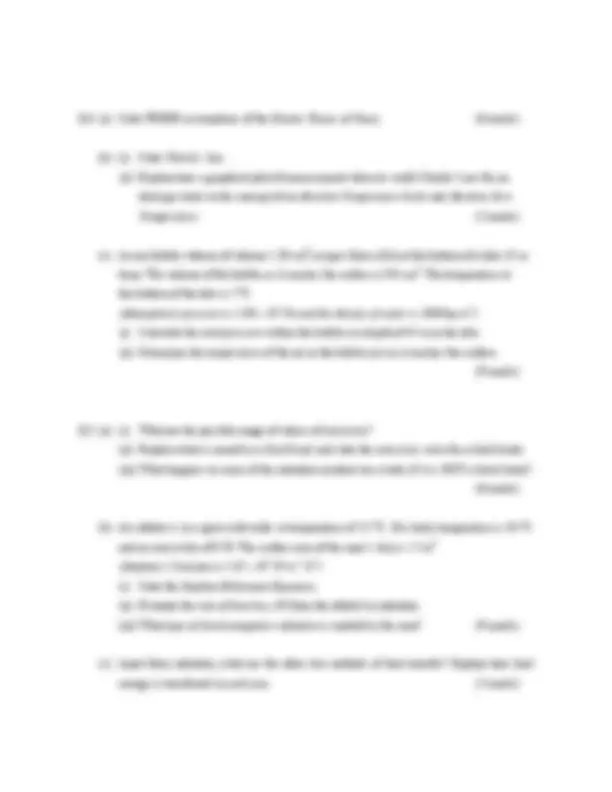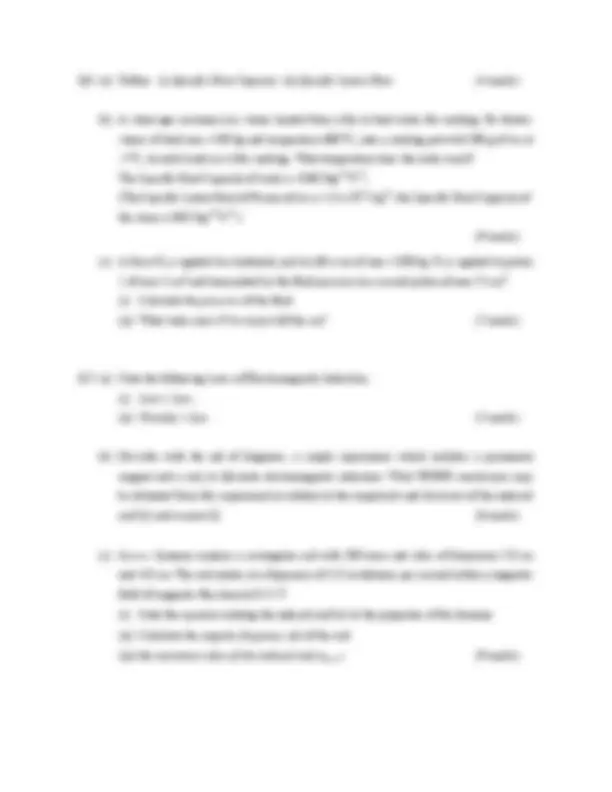




Study with the several resources on Docsity

Earn points by helping other students or get them with a premium plan


Prepare for your exams
Study with the several resources on Docsity

Earn points to download
Earn points by helping other students or get them with a premium plan
Community
Ask the community for help and clear up your study doubts
Discover the best universities in your country according to Docsity users
Free resources
Download our free guides on studying techniques, anxiety management strategies, and thesis advice from Docsity tutors
Main points of this past exam are: Equivalent Resistance, Equivalent Circuit, Capacitor Charges, Capacitor with Capacitance, Calculate Time Constant, Maximum Charge, Lens Equation, Height of Image, Dispersion of Light
Typology: Exams
1 / 4

This page cannot be seen from the preview
Don't miss anything!



Answer (^) FIVE questions (^) only. Show ALL working to gain full marks. Assume: g = 10.0 ms -
Examiners: Mr. T. Corcoran Prof. P. O Donoghue Dr. M.E. Woods
Q1. (a) State Ohm’s Law. (2 marks) (b) Figure 1 is an electrical circuit with five resistors labelled R 1 to R 5 and a battery of emf ε. (i) Calculate the equivalent resistance of resistors R 3 , R 4 and R 5. (ii) Hence calculate the equivalent resistance Req of the complete circuit. Sketch the equivalent circuit for the circuit in figure 1.
(9 marks)
12 Ω
ε R^5
Figure 1 (c) A capacitor with a capacitance C = 10.0 μF is connected in series with a resistor of resistance R = 20 kΩ, a battery of emf ε = 9.0 V, and a switch. When the contacts of the switch are closed, capacitor charges and the time (t) dependence of its potential Vc is given by: V (^) c = V 0 (1 - e-t/CR)
(ii) Calculate the maximum charge Q 0 stored on the capacitor. (iii) Sketch a plot of V (^) c versus t and indicate on the graph the value of Vc when t = τ. (9 marks)
Q2. (a) A thin biconvex converging lens has a focal length f. When an object is placed a distance u from the optic centre of the lens, an image is formed at a distance v from the lens. Prove from first principles the Lens Equation : (^) f^1 = u^1 + v^1 (7 marks) (b) A biconvex converging lens of focal length 10.0 cm is placed in contact with a biconcave diverging lens of focal 20.0 cm. Calculate the focal length of the combination. State, with a reason, whether the combined lens is converging or diverging. (6 marks)
(c) An object of height 4.0 cm is placed 9.0 cm in front of a biconcave diverging lens of focal length 6.0 cm. Draw a 1: 1 scale ray diagram on graph paper to determine the position , orientation , nature and height of the image. ( Calculations using the lens equation will not be accepted ) (7 marks)
Q3. (a) (i) What is meant by the dispersion of light? (ii) Sketch diagrams of TWO different methods of producing dispersion for a stated light source. Indicate on each of the diagrams, the name of the physical process involved and the instrument required, to produce dispersion. (8 marks)
(b) The displacement y(x,t) of a sinusoidal water wave has a time (t) and position (x) dependence given by: y(x,t) = 25 sin (20πt - 3πx/4) Determine:
(ii) Sketch a plot of y versus t at x = 0 metres to indicate the period and amplitude of the wave. (iii) Determine the equation for the particle velocity. Hence calculate its maximum value. (iv) Explain why a water wave is categorised as a transverse wave. (12 marks)
Q6. (a) Define: (i) Specific Heat Capacity : (ii) Specific Latent Heat. (4 marks)
(b) A stone-age caveman uses stones heated from a fire to heat water for cooking. He throws stones of total mass 4.00 kg and temperature 600 o^ C, into a cooking pot with 500 g of ice at -5 o^ C, to melt it and use it for cooking. What temperature does the water reach? The Specific Heat Capacity of water is 4200 Jkg-1^ o^ C-1^ ; (The Specific Latent Heat of Fusion of ice is 2.3 x 10^6 J kg -1^ ; the Specific Heat Capacity of the stone is 840 Jkg-1^ o^ C -1^ .) (9 marks) (c) A force F 1 is applied to a hydraulic jack to lift a car of mass 1200 kg. F 1 is applied to piston 1 of area 5 cm^2 and transmitted by the fluid pressure to a second piston of area 75 cm^2. (i) Calculate the pressure of the fluid. (ii) What value must F 1 be to just lift the car? (7 marks)
Q7. (a) State the following Laws of Electromagnetic Induction: (i) Lenz’s Law ; (ii) Faraday’s Law. (5 marks)
(b) Describe with the aid of diagrams, a simple experiment, which includes a permanent magnet and a coil, to illustrate electromagnetic induction. What THREE conclusions may be obtained from this experiment in relation to the magnitude and direction of the induced emf (ε) and current (I). (6 marks)
(c) An a.c. dynamo contains a rectangular coil with 100 turns and sides of dimension 2.0 cm and 4.0 cm. The coil rotates at a frequency of 125 revolutions per second within a magnetic field of magnetic flux density 0.12 T. (i) State the equation relating the induced emf (ε) to the properties of the dynamo.